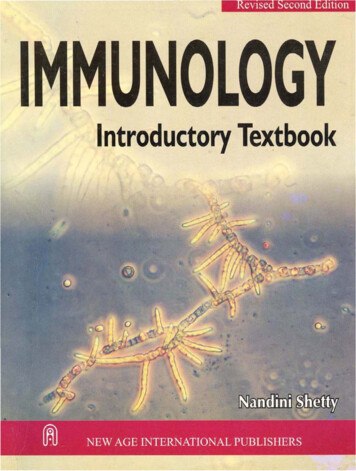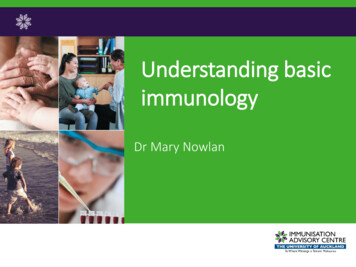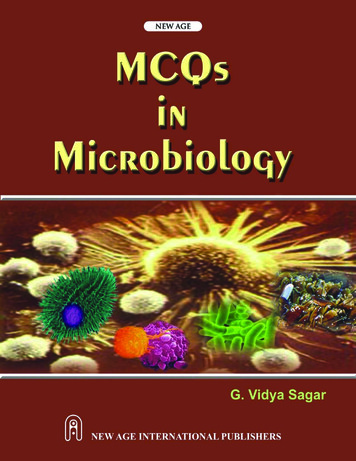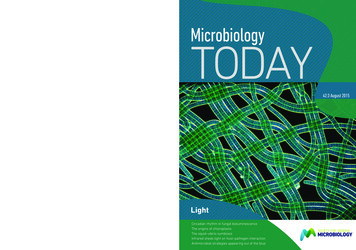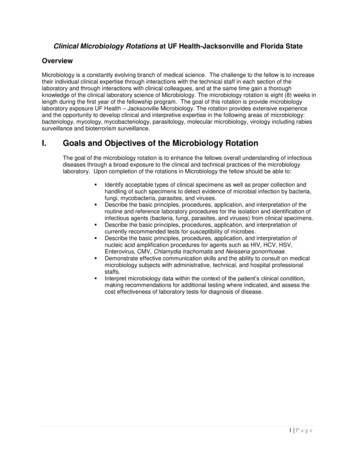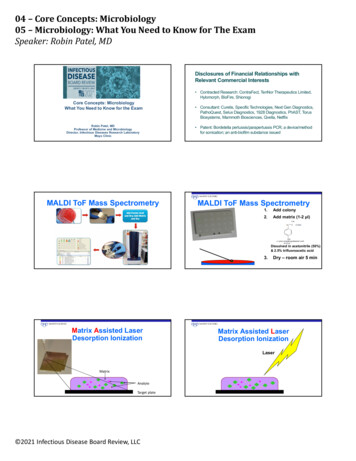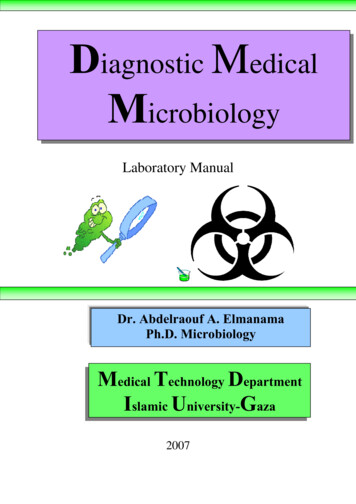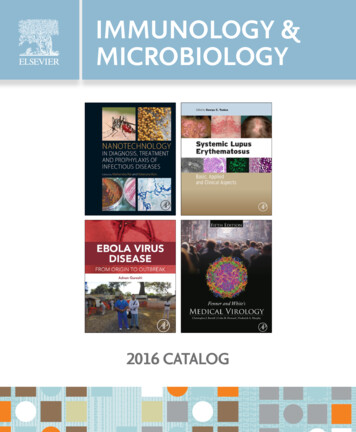
Transcription
IMMUNOLOGY &MICROBIOLOGY2016 CATALOG
Elsevier Science and Technology Books deliver targeted content thatenables the understanding and application of research. Year after yearreaders use our books to drive advancements in their fields.Tools and content on ScienceDirect offer: Full-text version online ordownload and print with nodigital rights managementrestrictions (DRM) Portable content available oncomputers, tablets and smartphonesto give users information in theformat that best suits their needs Multi-user/concurrentaccess at any time from anylocation to expand the reachof the content to your patrons Integrated book and journalcontent for easier access to relatedmaterials Free MARC records to drivediscoverability and usageOur foundational content—includingReference Modules, uniqueresources that are trustworthy,current, discoverable, and hostedon ScienceDirect—complementsoriginal research in journal articles.Our Legacy Collection on ScienceDirect, in 20 subject areas, ensures that valuablehistorical content is discoverable and searchable, saving time and resources.
Table of ContentsStay ConnectedBiology.2Stay connected withElsevier on Facebook,Twitter, YouTube andLinkedIn. These sitesare full of news, resources,offers and discussions.Communicate with us andother librarians,researchers,and professionals inyour field.View all obiology.24Molecular Biology. 33Professional and Career Development. 47Serials. 52Titles Index. 103Sales Representatives Index. 108Elsevier Books Customer Service Contacts.113Imprints.114PricingPublication dates, prices,and other details subject tochange without notice.virtuale.elsevier.com1
Kaufman’s Atlas of Mouse Development SupplementWith Coronal SectionsEdited by: Richard Baldock Biomedical Systems Analysis, MRC (Medical Research Council)Human Genetics Unit, University of Edinburgh Western General Hospital, Edinburgh, UK;Jonathan Bard Bioinformatics & Development, University of Edinburgh, Edinburgh, UK;Duncan Davidson Biomedical Systems Analysis, MRC Human Genetics Unit, University ofEdinburgh Western General Hospital, Edinburgh, UK;Gillian Morriss-Kay Dept. of HumanAnatomy and Genetics, University of Oxford, Oxford, UKA supplement to the legacy publication on mouse development, with coronal sections andupdated anatomical chaptersISBN: 978-0-12-800043-4PUB DATE: December 2015FORMAT: HardbackPAGES: c. 334AUDIENCEResearchers, graduate students indevelopmental biology, anatomy,neuroscience, and in all fields acrossbiological and biomedical research.2KEY FEATURES Provides high-resolution images for best visualization of key developmental processes andstructures Offers in-depth anatomy and morphological views of organ systems Written descriptions convey developmental origins of the organ systemsDESCRIPTIONKaufman's Atlas of Mouse Development: With Coronal Sections continues the stellar reputation ofthe original Atlas by providing updated, in-depth anatomical content and morphological views oforgan systems.The publication offers written descriptions of the developmental origins of theorgan systems alongside high-resolution images for needed visualization of developmentalprocesses. Matt Kaufman himself has annotated the coronal images in the same clear, meticulousstyle of the original Atlas. Kaufman's Atlas of Mouse Development: With Coronal Sections followsthe original Atlas as a continuation of the standard in the field for developmental biologists andresearchers across biological and biomedical sciences studying mouse development.LIFE SCIENCESBIOLOGYPlease contact your Elsevier Sales or Customer Service Representative
The Biology and Identification of the Coccidia(Apicomplexa) of Marsupials of the WorldDonald W. Duszynski Department of Biology, University of New Mexico,Albuquerque, NM, USAThis book is the first and only taxonomic summation of apicomplexan parasites of marsupialsthat allows easy parasite identification with a summation of virtually everything known aboutthe biology of each known parasite species, including viruses, protozoa, worms, arthropods, andmore.ISBN: 978-0-12-802709-7PUB DATE: November 2015FORMAT: HardbackPAGES: c. 242AUDIENCEResearchers in biology, parasitology,veterinary parasitology, animalhusbandry, diseases of wild anddomestic animals, veterinarymedicine, faculty members inuniversities with graduate programsin these areas, colleges of veterinarymedicine and agriculture, practicingveterinarians, farmers, students andother individuals involved in 4-H (4H is a youth organizationadministered by the NationalInstitute of Food and Agriculture ofthe United States Department ofAgriculture).KEY FEATURES Offers line drawings and photomicrograph of each parasite from each hosts species, includingmethods of identification and treatment Presents a complete historical rendition of all known publications on coccidia (and theirclosest relatives) from all marsupials species on Earth, and evaluates the scientific andscholarly merit of each Provides a complete species analysis of the known biology of every coccidian described frommarsupials Reviews the most current taxonomy of marsupials and their phylogenetic relationshipsneeded to help assess host-specificity and evaluate what little cross-transmission work isavailableDESCRIPTIONThe Biology and Identification of the Coccidia (Apicomplexa) of Marsupials of the World containsthe most up-to-date information on the former order marsupial that is now partitioned bymammalogists into seven separate orders that contain 20 families, 86 genera, and 318 species thatlive on land or in trees in Oceania and the Americas.Marsupials, like other vertebrate animals have many different kinds of parasites (e.g. viruses,protozoa, worms, arthropods, etc.), but there is no definitive text that covers any one of thesegroups found in all marsupials.Coccidiosis is a serious global problem in most domesticated animals, and under increasingcircumstances of loss of habitat and crowding, may also affect some wild animal populations, thus,there is a real need for their identification and control.LIFE SCIENCESBIOLOGYPlease contact your Elsevier Sales or Customer Service Representative3
Lessons in Immunity: From Single-cellOrganisms to MammalsEdited by: Loriano Ballarin Department of Biology, University of Padova,ItalyMatteo Cammarata Department of Biological, Chemical andPharmaceutical Sciences and Technologies, University of Palermo, ItalyThis helpful resource provides a series of overviews depicting the current state of various fieldsof immunobiology from an evolutionary perspective, furnishing a valuable, holistic, crosssectional approach for teaching immunology and its applicationsISBN: 978-0-12-803252-7PUB DATE: June 2016FORMAT: PaperbackPAGES: c. 298AUDIENCEThe book is primarily intended forscientists/ university teachers andresearchers in comparative(invertebrate and vertebrate)immunobiology. In addition, it offersan evolutionary approach which is anovelty also for teachers andstudents of medical schools.4KEY FEATURES Provides simple and updated reviews on the immunobiology of a wide spectrum of organisms,considered in an evolutionary context Focuses on both cells and humoral components of a variety of non-classical model organisms Offers in a single volume many contributions which can help with understanding the evolutionof immune responses and the main adaptations in animal phyla Presents a valuable holistic cross-sectional approach for teaching immunology and itsapplicationsDESCRIPTIONLessons in Immunity: From Single-cell Organisms to Mammals stems from the activity of the ItalianAssociation of Developmental and Comparative Immunobiology (IADCI), represented by theeditors. This book is presented as a series of short overviews that report on the current state ofvarious relevant fields of immunobiology from an evolutionary perspective. The overviews arewritten by authors directly involved in the research, and most are members of the IADCI or haveotherwise been involved in the related research for their respective overview. This publicationoffers scientists and teachers an easy and updated reference tool.LIFE SCIENCESIMMUNOLOGYPlease contact your Elsevier Sales or Customer Service Representative
Sjogren's SyndromeNovel Insights in Pathogenic, Clinical and Therapeutic AspectsEdited by: Alunno Alessia Rheumatology Unit, Department of Medicine,University of Perugia, I-06126 Perugia, ItalyBartoloni Elena Rheumatology Unit, Department of Medicine, Universityof Perugia, I-06126 Perugia, ItalyRobert Gerli Professor of Rheumatology, Department of Medicine,University of Perugia, ItalyAn overview of the current state of understanding of Sjogren's Syndrome (SS, this booksummarizes the large body of literature on advances in SS's genetic background, clinical picture,therapeutic approaches, and pathogenesisISBN: 978-0-12-803604-4PUB DATE: June 2016FORMAT: HardbackPAGES: c. 310AUDIENCEThis book is primarily intended forpeople already aware of SS whowould like to be updated on recentinsights into this disease. Since thisbook integrates basic immunologyconcepts, clinical aspects andpharmacological issues, it can be ofhelp both to scientists (graduatestudents/PhD/Post docs/lecturers)who focus their research on thisfield and to clinicians (graduatestudents, fellows and consultants)who care for SS patients.KEY FEATURES Discusses heterogeneity of topics and audience, from basic immunology to clinical aspects andtherapeutics Provides novel lines of investigation and supports the management of patients requiring noveltherapeutic approaches Presents a deeper knowledge on SS clinical management as well as on immunological aspectspossibly leading to new lines of investigation Offers a bridge between the clinician and the scientist, and vice versa Provides the reader with most recent and relevant updates due to the novelty of topicsDESCRIPTIONSjogren's Syndrome: Novel Insights in Pathogenic, Clinical and Therapeutic Aspects provides thereader with an overview of current knowledge about Sjogren's Syndrome. The book summarizesthe huge amount of literature concerning related advances in genetic background, pathogenesis,clinical picture, and therapeutic approaches. It integrates basic immunology concepts, clinicalaspects, and pharmacological issues.Scientific progress has allowed us to unmask novel pathogenic mechanisms, to perform genomewide studies, and to identify clinical and serological features associated with different diseasesubsets and, eventually, different disease prognoses. In addition, the increasing knowledge aboutSS pathogenesis provides the rationale to employ targeted therapies in SS as has already occurredin rheumatoid arthritis and systemic lupus erythematosus.LIFE SCIENCESIMMUNOLOGYPlease contact your Elsevier Sales or Customer Service Representative5
Core Concepts in Clinical Infectious Diseases(CCCID)Carlos Franco-Paredes Infectious Diseases Clinician, Adjunct ClinicalProfessor, Hospital Infantil de Mexico, Federico Gomez, Mexico City,MexicoThis insightful book provides key clinical concepts used in the differential diagnosis and workupof infectious diseases, discusses a helpful approach for organizing and thinking about commonlyseen clinical presentationsISBN: 978-0-12-804423-0PUB DATE: June 2016FORMAT: PaperbackPAGES: c. 200AUDIENCEResearchers and advanced studentsin the fields of infectious diseases,microbiology, public health andimmunologyKEY FEATURES Assists the reader in connecting the dots (process of accumulating real-time knowledge)during the thinking process of clinical decision-making in the area of infectious diseases Uses tables and charts for easy understanding and application Contains a manual style that targets different audiences, such as medical students, hospitalmedicine specialists, outpatient internal medicine practitioners, infectious disease fellows intraining, and practicing clinicians Provides an up-to-date discussion of core concepts in clinical infectious diseasesDESCRIPTIONCore Concepts in Clinical Infectious Diseases (CCID) provides medical students and researchers,infectious disease fellows, and practicing clinicians with key clinical concepts in the differentialdiagnosis and workup of infectious diseases. With the use of tables, charts, and problem-orientedmedical diagnosis, it will provide a way of organizing and thinking about commonly seen clinicalpresentations of infectious diseases. Instead of discussing each disease process or any particularinfectious process, this book will assist clinicians in seeing the forest and not focusing on the leaf.Graphs and tables have been constructed over 14 years of taking notes, teaching clinical infectiousdiseases, and discussing real clinical cases. This book is not about acquiring the structure ofinfectious diseases that is presented in classic textbooks of infectious disease; instead, it is aboutrefining the process of putting the pieces together in clinical thinking to achieve an accurateclinical diagnosis and thus improved patient care.6LIFE SCIENCESIMMUNOLOGYPlease contact your Elsevier Sales or Customer Service Representative
The Innate Immune Response to Noninfectious StressorsHuman and Animal ModelsEdited by: Massimo Amadori Laboratory of Cellular Immunology, IZSLER,Brescia, ItalyThis book describes the rationale behind the innate immune response to non-infectiousstressors and relevant human and animal models, covering the crucial link between stressresponse and energy metabolism and prompting a reappraisal of some crucial issues in thisfascinating, somehow elusive field of investigationISBN: 978-0-12-801968-9PUB DATE: March 2016FORMAT: PaperbackPAGES: c. 244AUDIENCEresearchers, academic scientists,and graduate students focused oninnate immunologyKEY FEATURES Provides insights into the fundamental homeostatic processes vis-à-vis stressors to help ininvestigation Illustrates the depicted tenets and how to offset them against established models of responseto physical and psychotic stressors in both animals and humans Covers the crucial issue of the immune response to endocrine disruptors Includes immunological parameters as reporter system of environmental adaptation Provides many illustrative examples to foster reader understandingDESCRIPTIONThe Innate Immune Response to Non-infectious Stressors: Human and Animal Models highlightsfundamental mechanisms of stress response and important findings on how the immune system isaffected, and in turn affects such a response. In addition, this book covers the crucial link betweenstress response and energy metabolism, prompts a re-appraisal of some crucial issues, and helpsto define research priorities in this fascinating, somehow elusive field of investigation.LIFE SCIENCESIMMUNOLOGYPlease contact your Elsevier Sales or Customer Service Representative7
Insights to Neuroimmune Biology, 2eEdited by: Istvan Berczi Department of Immunology, University ofManitoba, MB, CanadaThis comprehensive publication fulfills the urgent need for updated and revised tools, models,and techniques that can enhance the study of neuroimmune interactions at molecular levels,with an ultimate goal of helping readers understand the function of higher organisms, includingman, in their entire complexityISBN: 978-0-12-801770-8PREVIOUS EDITION ISBN:9780123846914PUB DATE: February 2016FORMAT: HardbackPAGES: c. 292AUDIENCEScientists and practitioners of theImmunology, biology, Medicine,Veterinary Science and Zoology. Thisbook could serve to helpNeuroscientists and Medical andVeterinary doctors in advancedtraining.8KEY FEATURES Provides information on the importance and applicability of the field of neuroimmunology Describes subjects that have shown significant recent developments Introduces a whole new dimension to neuroimmunology by discussing EpigeneticImmunoregulation Investigates the mechanisms and functions of the Neuroimmune Regulatory Supersystem Promotes translational research in the field of neuroimmune biology Covers challenges, such as dealing with problems of e.g., hypothalamic regulation of immunefunctions, interrelationships of stress and disease, epigenetic immunoregulation,neuroprotection, and neuroimmune regulation in pregnancy.DESCRIPTIONInsights to Neuroimmune Biology, Second Edition discusses the systemic regulatory network,coordination, organization, and interpretation of the rapidly accumulating knowledge on the topicof neuroimmune biology, with an ultimate goal of helping readers understand the function ofhigher organisms, including man, in their entire complexity.This publication provides assessments and interpretations of accumulated experimental evidence,enabling the scientific community to keep abreast of essential advancements of existingknowledge as we search for greater understanding of the biology of higher organisms.LIFE SCIENCESIMMUNOLOGYPlease contact your Elsevier Sales or Customer Service Representative
Systemic Lupus ErythematosusBasic, Applied and Clinical AspectsEdited by: George C. Tsokos Professor of Medicine, Harvard MedicalSchool, and Chief, Rheumatology Division, Beth Israel Deaconess MedicalCenter, Boston, MA, USAPresents each topic on Systemic Lupus Erythematosus in a critical, easily accessible mannerISBN: 978-0-12-801917-7PUB DATE: March 2016FORMAT: PaperbackPAGES: c. 614AUDIENCEresearchers in basic, applied, andclinical immunologyKEY FEATURES Provides the very latest overview of the pathogenesis of SLE Distills current understanding of the cellular, molecular, genetic and environmental factorsthat instigate and drive the disease Includes comprehensive coverage of clinical features, including fatigue, organ systemmanifestations, overlap syndromes, infections, and more Conveys the very latest understanding of mechanisms of tissue damage, including immunecomplexes, antibodies, and other mechanisms that lead to organ damage Discusses the latest treatment options on disease modifying or disease controlling agents Provides 'one stop' coverage of all the latest scientific and clinical developments in SLEDESCRIPTIONSystemic Lupus Erythematosus combines basic science with clinical science to provide atranslational treatment of the disease and is a useful reference for specialists in the diagnosis andmanagement of patients with SLE, a tool for measurement of clinical activity for pharmaceuticaldevelopment and basic research of the disease and a reference work for hospital libraries.LIFE SCIENCESIMMUNOLOGYPlease contact your Elsevier Sales or Customer Service Representative9
Immune RebalancingThe Future of ImmunosuppressionEdited by: Diana Boraschi PhD, Research Director, Institute of BiomedicalTechnologies, Italian National Research Council, Pisa, ItalyGiselle Penton-Rol Center for Genetic Engineering and Biotechnology(CIGB), Havana, CubaDescribes new perspectives of immunopharmacology focused on immunosuppression.ISBN: 978-0-12-803302-9PUB DATE: February 2016FORMAT: PaperbackPAGES: c. 284AUDIENCEResearchers and scientists in thefield of immunology, pharmacologyand biomedical research andindustrial researchers involved indeveloping new therapeuticproducts. Also for clinicians andmedical doctors interested inevaluating new treatment options.Secondary audience: Graduate andadvanced students.10KEY FEATURES Visits immunosuppression from a modern point of view of signalling mechanisms at the lightof the current knowledge of signalling mechanisms and regulatory networks allows the readerto formulate new ideas and concepts on how to use immunosuppression the therapeuticpurposes Encourages researchers to engage into exploring the field of pharmacological modulation ofimmune responses in depth, and with the new knowledge and tools available, designs moreeffective therapeutic strategies to autoimmune and inflammatory diseases, cancer,degenerative diseases and infections Examines the link between molecular pathways associated to immune-suppression and thenew immunopharmacology approaches Provides information on the new strategies for drug development in this field Considers the role of microbes in the development of the mammalian immune system andimmune responses, which will widen the reader’s strategy for addressing therapeutic immunemodulationsDESCRIPTIONImmune Rebalancing: The Future of Immunosuppression summarizes the most promisingperspectives of immunopharmacology, in particular in the area of immunosuppression byconsidering molecular pathways, personalized medicine, microbiome and nanomedicine.Modulation of immune responses for therapeutic purposes is a particularly relevant area, giventhe central role of anomalous immunity in diseases. These diseases vary from the most typicallyimmune-related syndromes (autoimmune diseases, allergy and asthma, immunodeficiencies) tothose in which altered immunity and inflammation define the pathological outcomes (chronicinfections, tumours, chronic inflammatory and degenerative diseases, metabolic disorders, etc.LIFE SCIENCESIMMUNOLOGYPlease contact your Elsevier Sales or Customer Service Representative
Autophagy: Cancer, Other Pathologies,Inflammation, Immunity, Infection, and AgingVolume 8- Human DiseasesEdited by: M. A. Hayat Distinguished Professor, Department of BiologicalSciences, Kean University, Union, NJ, USAPresents up-to-date information on the role of Autophagy in health and disease in ninecomprehensive volumesKEY FEATURES ISBN: 978-0-12-802937-4PUB DATE: February 2016FORMAT: HardbackPAGES: c. 348AUDIENCEAcademic/clinical professors,postdoctoral fellows, graduate andmedical students in immunology,microbiology, pathology, infectiousdiseases and cancer research Presents the most advanced information regarding the role of the autophagic system in life and deathand whether autophagy acts fundamentally as a cell survivor, or cell death pathway, or bothIntroduces new, more effective therapeutic strategies, in the development of targeted drugs andprogrammed cell death, providing information that will aid on preventing detrimental inflammationStates recent advancements in the molecular mechanisms underlying a large number of genetic andepigenetic diseases and abnormalitiesDESCRIPTIONUnderstanding the importance and necessity of the role of autophagy in health and disease is vital for thestudies of cancer, aging, neurodegeneration, immunology, and infectious diseases. Comprehensive andforward-thinking, these books offer a valuable guide to both cellular processes while inciting researchers toexplore their potentially important connections.Volume 8 Autophagy and Human Diseases, concentrates on the role of Autophagy in human diseases,including tumorigenesis. The diseases discussed include melanoma, liver cancer, pancreatic cancer, andneurodegenerative disorders. Loss of autophagy in the central nervous system causes neurodegeneration(Alzheimers disease, Huntington’s disease, Parkin’s disease, and Amyotrophic Lateral Sclerosis). Melanoma isone of the most serious diseases in humans. Autophagy plays a key role in the anticancer response toChemotherapy. However, autophagy can increase or decrease the effectiveness of chemotherapy. Thereasons for these contradictory effects are explained. Autophagy also plays a role in idiopathic inflammatorydiseases, infection, and immunity. An explanation is given how autophagy is closely linked to control of innateand adaptive immune responses in host defense in part by regulating cytokine production. The role ofautophagy in cutaneous malignant melanoma is discussed in detail and expression of Beclin 1 and LC3autophagic genes in melanoma is included to explain the molecular mechanisms underlying this very seriousdisease, which tends to metastasize to the brain. The effect of the treatment of this disease usingTerfenadine through the induction of autophagy and apoptosis is also included. Autophagy and apoptosis aretwo main mechanisms involved in programmed cell death.Considering that autophagy is associated with numerous biological processes including cellular developmentand differentiation, cancer (both antitumor and protumor functions), immunity, infectious diseases,inflammation, maintenance of homeostasis, response to cellular stress, and degenerative diseases such asAlzheimer’s, Parkinson's, Huntington's, amyotrophic lateral sclerosis, and prion diseases, there is a great needto understanding its role. Cell homeostasis is achieved by balancing biosynthesis and cellular turnover. Inspite of the increasing importance of autophagy in various pathophysiological situations (conditions)mentioned above, this process remains underestimated and overlooked. As a consequence, its role in theinitiation, stability, maintenance, and progression of these and other diseases (e.g., autoimmune disease)remains poorly understood.LIFE SCIENCESIMMUNOLOGYPlease contact your Elsevier Sales or Customer Service Representative11
Translational ImmunologyMechanisms and Pharmacologic ApproachesSeng-Lai Tan EMD Serono Research and Development Center, Billerica,MA, USAA comprehensive overview of the mechanisms underlying emerging pharmacologic approachesto interventional immunologyISBN: 978-0-12-801577-3PUB DATE: December 2015FORMAT: HardbackPAGES: c. 370AUDIENCEresearchers, scientists, physicians,graduate students, postdocs, andinstructors/teachers interested intranslational studies in humanimmunologyKEY FEATURES Delivers comprehensive coverage of seminal human immunology discoveries and the resultingimpact on therapeutic strategies Presents potential novel targets and approaches for clinical applications in organ specific andsystemic autoimmunity, transplant rejection, cancer, and vaccine development Discusses lessons learned from successful and failed clinical trials with specific interventions,including pharmacological issues and limitations, and complications due toimmunosuppression Provides information on new strategies and outstanding issues that should be addressed infuture researchDESCRIPTIONTranslational Immunology: Mechanisms and Pharmacologic Approaches highlights andsummarizes the most important advances in human immunology, clinical translations, new toolsto analyze therapeutic targets, and new pharmacological approaches for autoimmunity,inflammatory disorders, and cancer. The book is an essential resource for those seeking tounderstand the potential translational applications of burgeoning studies in human immunology,helping readers make sense of the existing and emerging scientific advances. The book groundsfundamental science in the translational realm, providing insights from world renownedresearchers at the top of their game in their respective fields, in both industry and academicsettings.Readers will gain an understanding of the rationale and mechanisms underlying current andemerging pharmacologic approaches for interventional immunology, the gaps therein, and newideas for better and safer therapeutic approaches, and physicians will glean information aboutpharmacological limitations in altering disease progression and complications. This reference onthe translational realization of the burgeoning findings in immunology provides a go-to referencefor experienced professional clinicians, researchers, industry scientists, and those seeking moreinformation on the field.12LIFE SCIENCESIMMUNOLOGYPlease contact your Elsevier Sales or Customer Service Representative
A Historical Perspective on Evidence-BasedImmunologyEdward J. Moticka Professor, Department of Immunology andMicrobiology, A.T. Still University School of Osteopathic Medicine, Mesa,AZ, U.S.A.Highlights the evidence supporting immunology concepts commonly taken for granted, includingresults of hypothesis-driven controlled scientific experimentsISBN: 978-0-12-398381-7PUB DATE: December 2015FORMAT: PaperbackPAGES: c. 380AUDIENCEgraduate and undergraduatestudents entering the fields ofimmunology, molecular biology andother biomedical disciplines, theirinstructors and mentors.Researchers, practitioners and thoseinterested in the evolution of ideasand scientific methodsKEY FEATURES Provides a complete review of the hypothesis-driven, controlled scientific experiments thathave led to our current understanding of immunological principles Explains the types of experiments that were performed and how the interpretation of theexperiments altered the understanding of immunology Presents concepts such as the division of lymphocytes into functionally different populationsin their historical context Includes fundamental insights on immunologic tolerance, interactions of lymphocytes withantigen TCR and BCR, and the generation of diversity and mechanism of tolerance of T and BcellsDESCRIPTIONA Historical Perspective on Evidence-Based Immunology focuses on the results of hypothesisdriven, controlled scientific experiments that have led to the current understanding ofimmunological principles. The text helps beginning students in biomedical disciplines understandthe basis of immunologic knowledge, while also helping more advanced students gain furtherinsights.The book serves as a crucial reference for researchers studying the evolution of ideas and scientificmethods, including fundamental insights on immunologic tolerance, interactions of lymphocyteswith antigen TCR and BCR, the generation of diversity
reader with an overview of current knowledge about Sjogren's Syndrome. The book summarizes the huge amount of literature concerning related advances in genetic background, pathogenesis, clinical picture, and therapeutic approaches. It integrates basic immunology
